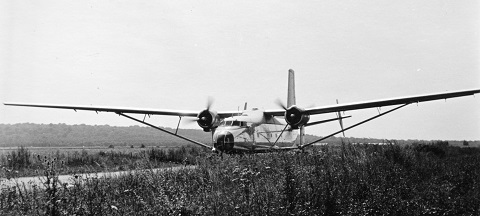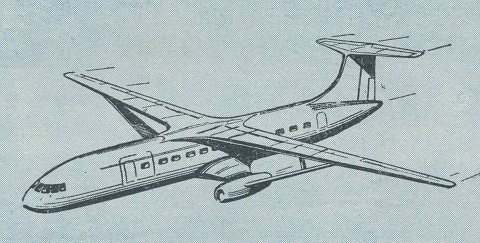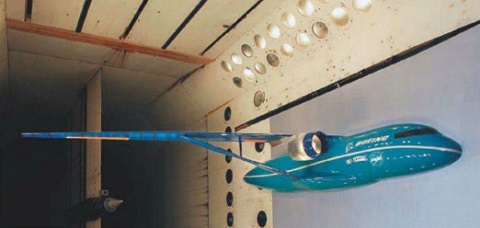|
|
|
Long wings for efficient flying: from Hurel Dubois to Subsonic Ultra Green Aircraft Research (SUGAR)
|
|
|
Presently NASA studies in cooperation with Boeing concepts for future aircraft. One of these concepts is an aircraft with extremely long, slender wings. This idea is not new, and of course practically used in gliders and airplanes to fly at high altitudes. But already over 60 years ago there were plans in France to apply large, motorized aircraft with slender wings.
That ideas only in the second place find general application is not new. Progress in knowledge and technology sometimes direct back to old solutions. Perhaps this is also the case for the long wing. Modern aircraft like the Boeing 787, Diamond DA.42 and Bombardier CS have already, in a less extreme form, relatively long, slender wings.
|
|
|
Induced drag
Long slender wings (in technical language: wings with high aspect ratio) take care for a reduction of 10-15% in drag compared to conventional, simple wings as for example applied on basic sport aircraft like the Cessna 172 or Piper PA-28. Aircraft drag can be separated into two parts: the parasite drag, and induced drag. The parasite drag originates from collisions between air particles and the aircraft and is therefore dependent on shape and smoothness of fuselage and wings. The induced drag is caused by the downwards bending of the airflow leaving the wing trailing edge. This causes the total upward load a wing generated to have a component in flow direction, so opposite of the trust the engine(s) deliver(s). This effect increases (like the total upward load on the wing) with the square of the airspeed (i.e. increase of the airspeed with a factor two delivers an induced drag increased with a factor four, for airspeed increase with a factor three the induced drag increases with a factor nine, etc.). In practise these kind of large airspeed changes will not happen (except during take-off), but also a small increase in airspeed will have a relative large effect on induced drag.
But induced drag decreases proportional with the wing aspect ratio: the more slender the wing is, the lower the induced drag it produces. That is one of the reason sailplanes have long wings: the less drag, the less they descends.
|
 Boeing SUGAR Volt concept
Boeing SUGAR Volt concept
|
|
Advantages and disadvantages
For motorized aircraft there is another important advantage in using high aspect ratio wings: the less drag, the less trust (or engine power) is needed. Or: more available thrust can be used to climb. And also, long wings offer the possibilities to equip the wing with a lot of flaps, who are used to decrease both take-off and landing lengths. Furthermore, a high aspect ratio gives an aircraft the capability to operate at a larger flight altitude than aircraft with conventional wings. The lower air densities at larger altitudes take care for lower parasite drag, which decreases fuel consumption.
But, naturally, high aspect ratio wings also have disadvantages. In the first place long wings are impractical at airports (Boeing will equip their 777X with folding wingtips for this reason), and strength design of long wings is complex. In general, for ultra-high aspect ratio wings, supports are needed to prevent extreme bending. And these supports cause of course additional drag which can cancel out the gain from reduced induced drag.
|
 Hurel Dubois HD.34 shows it huge wing span
Hurel Dubois HD.34 shows it huge wing span
|
|
Hurel Dubois
Almost all these items can be found back in the 1950’s aircraft designs of the French company Hurel Dubois. In 1950, an experimental sport plane designed by Marcel Dubois attracted attention. It combined a wing span of 12 meters with a cord (“width” of the wing) of 40 cm. The wings needed supports, but the effectivity of the concept was illustrated by the fact that it only needed a few litres of fuel to fly 100 km at cruise speed. The French government supported Dubois, who had the intention to apply high aspect wings on larger commercial aircraft. This was given shape in the Hurel Dubois HD.31: a twin piston engine aircraft with a wing span of 45 meter, more than twice the fuselage length. Although the aircraft was structurally complex and was equipped with large wings supports and a fixed undercarriage, Air France showed interest and placed an order for 24 aircraft. There was also a version with jet engines on the drawing boards: the HD.45, but this project was abandoned after the French government decided to support the Caravelle jet instead. The HD.31 did not become a success either: in the end Air France cancelled the order and choose for jet aircraft. Only eleven HD.31s (including some of the almost similar HD.32 and HD.34) were built, of which eight were delivered to the Institut Géographique National (IGN), which used the aircraft for aerial mapping until 1976.
|
 Hurel Dubois HD.45 did not leave the drawing office
Hurel Dubois HD.45 did not leave the drawing office
|
|
SUGAR
Back to the present. Since 2010 the US National Aerospace Agency (NASA) works on the Subsonic Ultra Green Aircraft Research (SUGAR) program, which aims to develop new concepts for effective airliners. In cooperation with Boeing, a concept is being worked out which combines the use of ultra-high aspect ratio wings with revolutionary hybrid (fuel/electrical) engines. The Boeing SUGAR Volt, as the concept is dubbed, is being subjected to wind tunnel tests and shows a remarkable similarity with the 60 year old Hurel Dubois HD.45.
|
 SUGAR Volt-2 windtunnel model
SUGAR Volt-2 windtunnel model
|
|
Sources
- Graham Warwick - “Different Aspect” in Aviation Week and Space Technology, January 27, 2014
- E.W. de Wilde de Ligny – “de formule van Hurel” in Avia Vliegwereld (in Dutch), March 18, 1954
- “The Hurel Dubois HD.32” in Air-Britain Archive, summer 2013
|
|
 Boeing SUGAR Volt concept
Boeing SUGAR Volt concept
 Hurel Dubois HD.34 shows it huge wing span
Hurel Dubois HD.34 shows it huge wing span
 Hurel Dubois HD.45 did not leave the drawing office
Hurel Dubois HD.45 did not leave the drawing office
 SUGAR Volt-2 windtunnel model
SUGAR Volt-2 windtunnel model